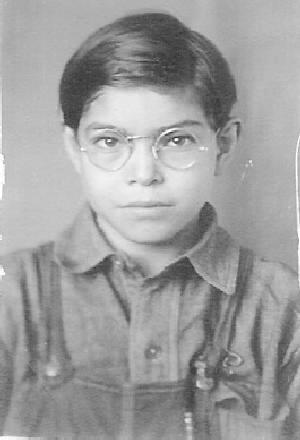
Boys' Eye Glasses: Types

Figure 1.--There were many types of eye glasses developed to assizt with vission. The type most commonly worn by children were eye glassess. Both boys and girls wore the same styles of eyes glasses until after World War II. Here we see see the school picture of an unidentified farm boy during the 1920s.
|
|
There are several many different types of glassess and their popularity has varied over time. We see monacles, pince-nez, eye glasses, and contact lens. Monacles were rarely worn by boys. This was an eye glass time more reserved for aristocrats and Prussian junkers. Prinz-nez were double lens eye glasses, but without the arms for support over the ears. We see a few boys wearing them in the 19th century, but not very many. A good exanple is an unidentified New York boy, we think in the late 1880s. Standard eye glasses had two lens and supporting arms. They are often calld spectacles. This was the type most commonly worn by boys. We note many different styles. Wire rim frames were popular in the late-19th and early 20th century. A good example here is an English boy, HJ Whillockol about 1930. Another popular style were hornrims. These were originally made with turtle shell, but in the 20th century plastics were worn. There were turtle-shell colored plastics and well as black plastic frames. Both were commonly worn by boys. Plastic lens began to replace glass in the 1970s. At the same time we begin to see contact lenses.
Monacles
Monacles were rarely worn by boys. This was an eye glass time more reserved for aristocrats and Prussian junkers. Like pince-nez glasses, the usr of the monacle seems primary to avoid the social stigma associated with wearing glasses. The monacle was exclusively worn by men and not women. Boys rarely wore them.
Pince-nez
Prinz-nez were double lens eye glasses, but without the arms for support over the ears. Pince-nez glasses that clip onto the nose and are not held in place by side pieces that fit over the ears.
They seem to have first appeared in the 15th century, but were not very common. They were most common in the 19th cenury and very early 20th century. They began to be commonly worn un the 1840s and were quite common for adukts at the turn of the 20th century.
Teddy Roosevelt wore this kind of
glasses and so did Woodrow Wilson. They declined in popularity after World war I. They were seen as old fashioned in the 1920s. They were sometimes attached to a chain or ribbon (so they wouldn't fall to the ground and break if detached from the nose) although that wa not always the case. Pince-nez had a very aristocratic look, but sometimes were a bit uncomfortable because of the pinching mechanism on the nose. Pince-nez (French for "pinch the nose") almost never had frames around the lenses. One of the ideas was to minimize the effect of wearing glasses at all, which some thought detracted from a person's appearance. They are mostly identified with adults--and usually distinguished, dignified adults
We see a few boys wearing them in the 19th century, but not very many. A good exanple is an unidentified New York boy, we think in the late 1880s.
Lorgnettes
Lorgnettes were spectacles or opera glasses mounted on a stick or handle. They appear to have first appeared about the turn of the 19th century. The term seems to have origninated from a N=Middle French word for squinting. This was not a type of eye glasses used by boys or girls. It seems to have been primarily used by fashionable society women who did not want to wear glasses.
Standard Eye Glasses
Standard eye glasses had two lens and supporting arms. They are often calld spectacles. This was the type most commonly worn by boys. We note many different styles. Wire rim frames were popular in the late-19th and early 20th century. A good example here is an English boy, HJ Whillockol about 1930. Another popular style were hornrims. These were originally made with turtle shell, but in the 20th century plastics were worn. There were turtle-shell colored plastics and well as black plastic frames. Both were commonly worn by boys. Plastic lens began to replace glass in the 1970s. Eye glasses were primarially made with optical corrections to attempt to restore 20-20 vision. Therewere also sun glassess wittout optical correction.
Contact Lens
At the same time we begin to see contact lenses.
HBC

Navigate the Boys' Historical Clothing Web Site:
[Return to the Main eye glass page]
[Introduction]
[Activities]
[Advertisements]
[Biographies]
[Chronology]
[Clothing styles]
[Countries]
[Topics]
[Bibliographies]
[Contributions]
[FAQs]
[Glossaries]
[Images]
[Registration]
[Tools]
[Boys' Clothing Home]
Created: 7:08 PM 9/17/2008
Last updated: 7:08 PM 9/17/2008



